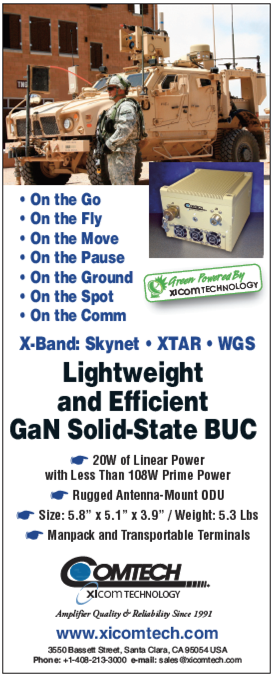NRO-37 Sent Off To Secret Work By United Launch Alliance + Aerojet Rocketdyne
A United Launch Alliance (ULA) Delta IV Heavy rocket carrying a payload for the National Reconnaissance Office (NRO) lifted off from Space Launch Complex-37 on June 11 at 1:51 p.m. EDT. The NROL-37 mission is in support of national defense.
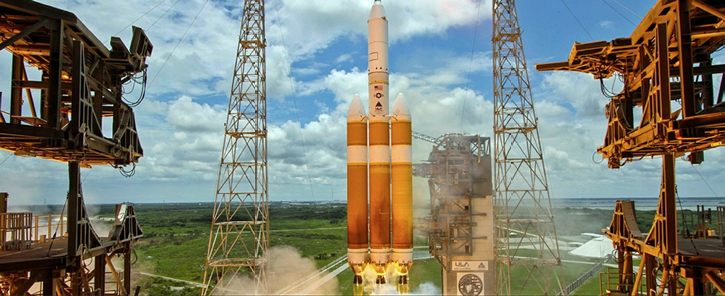
The launch of NROL-37 aboard a Delta IV Heavy. Photo courtesy of ULA.
Laura Maginnis, ULA vice president of Custom Services, said, “This was the ninth time ULA launched the Delta IV Heavy, the most powerful launch vehicle in existence today.”
This mission was launched aboard a Delta IV Heavy configuration Evolved Expendable Launch Vehicle (EELV), which featured a center common booster core along with two strap-on common booster cores. The ULA Delta IV Heavy is currently the world’s largest rocket, providing the nation with reliable and proven heavy lift capability.
Each common booster core was powered by an RS-68A Liquid Hydrogen/Liquid Oxygen engine producing 702,000 pounds of thrust. A single RL10 Liquid Hydrogen/Liquid Oxygen engine powered the second stage.
The booster and upper stage engines were both built by Aerojet Rocketdyne. ULA constructed the Delta IV Heavy launch vehicle in Decatur, Alabama.
“The team worked together through many challenges this flow including overcoming the after effects of Tropical Storm Colin,” said Maginnis. "We are proud of the outstanding teamwork between the ULA, NRO and Air Force partners to ensure mission success for this critical national security asset.”
ULA's next launch is the Atlas V MUOS-5 mission for the US Navy and the US Air Force, which is scheduled for June 24 from Space Launch Complex-41 at Cape Canaveral Air Force Station, Florida.
The EELV program was established by the US Air Force to provide assured access to space for Department of Defense and other government payloads.
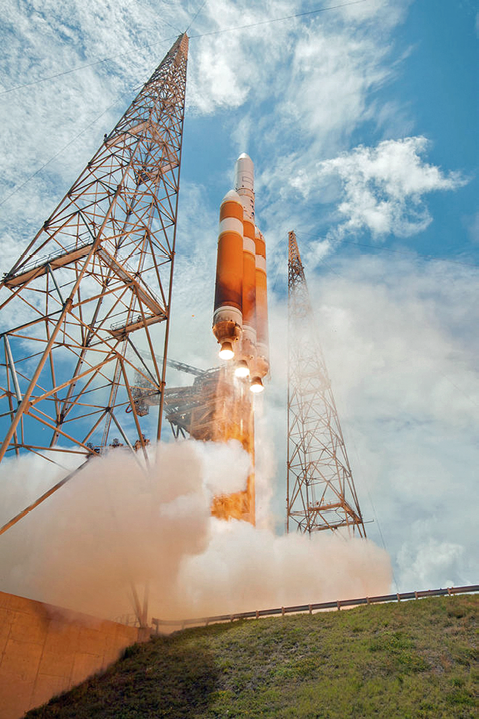
NROL-37 launch photo courtesy of ULA.
The commercially developed EELV program supports the full range of government mission requirements, while delivering on schedule and providing significant cost savings over the heritage launch systems.
ULA has successfully delivered more than 100 satellites to orbit that provide critical capabilities for troops in the field, aid meteorologists in tracking severe weather, enable personal device-based GPS navigation and unlock the mysteries of our solar system.
Few satellites are large enough that a Delta IV Heavy launch vehicle is required to reach geosynchronous transfer orbit. Past NRO launches to use this vehicle from the Cape have all traveled directly to geosynchronous orbit, which suggests that the payload will be an Orion electronic signals intelligence (ELINT) satellite
NROL-37 is the ninth launch of an Orion satellite, part of a series of spacecraft introduced in the mid-1980s to replace the earlier Aquacade satellites.
The flight, designated NRO Launch 37 (NROL-37), is the second of the year for the National Reconnaissance Office (NRO), following February’s NROL-45 mission which flew from Vandenberg Air Force Base, also atop a Delta IV and was also the second Delta launch of the year.
Aerojet Rocketdyne, Inc., a subsidiary of Aerojet Rocketdyne Holdings, Inc., successfully supported the launch this national security payload into orbit for the US government.
Three of the world’s most powerful hydrogen-fueled booster engines were used. Aerojet Rocketdyne propulsion included three RS-68A booster engines, an RL10B-2 upper-stage engine, multiple attitude control thrusters and 26 helium pressurization tanks.
“As a military veteran, I can personally attest to the importance of national security satellites for our nation’s troops deployed at home and overseas,” said Aerojet Rocketdyne CEO and President Eileen Drake. “Congratulations to everyone for another successful launch.”
During launch, three RS-68A engines ignited to boost the Delta IV Heavy off the pad, each providing 702,000 pounds of lift-off thrust.
The RS-68A is the world’s most powerful liquid-hydrogen/liquid-oxygen engine, and has now flown 32 commercial and government missions with 100 percent mission success.

After the upper stage separated from the launch vehicle, a single RL10B-2 ignited to provide 24,750 pounds of thrust to power the upper stage, using cryogenic liquid hydrogen and liquid oxygen propellants during its operation.
RL10B-2 is a liquid-fuel cryogenic rocket engine designed and developed from the RL10 family of upper-stage engines, which have accumulated one of the most impressive lists of accomplishments in the history of space propulsion.
The RL10 has helped place numerous military, government and commercial satellites into orbit over the last 50 years, and has powered scientific space-probe missions to every planet in our solar system.
ARDÉ, a subsidiary of Aerojet Rocketdyne based in New Jersey, provided the pressure vessels on the first and second stages of the launch vehicle.
ulalaunch.com
nro.gov/index.html
aerojetrocketdyne.com
SpaceX's Perfect Launch + Landing... A THAICOM-8 Send Off
"All looks good," reported SpaceX CEO Elon Musk.
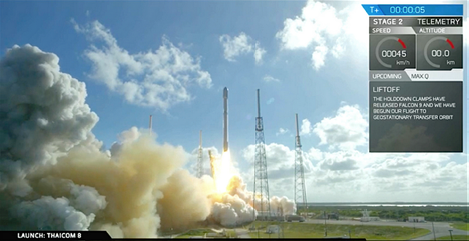
SpaceX landed its third consecutive rocket on May 27th, concluding a mission that successfully launched a commercial communications satellite to orbit—THAICOM 8.
“Falcon 9 has landed,” a member of SpaceX’s launch team confirmed about 10 minutes after a 230-foot Falcon 9 rocket's 5:39 p.m. blastoff from Cape Canaveral Air Force Station.
About 20 minutes later, the rocket's upper stage deployed the Thaicom 8 satellite into orbit, as planned.
Later, Musk said the rocket's first stage had landed at close to the top speed it was designed to handle, possibly undermining its stability on the ship floating more than 400 miles offshore.
"Prob OK, but some risk of tipping," he said on Twitter.
If the first stage remained upright, crews planned to board the unpiloted "drone ship" to weld shoes over the rocket's four landing legs and then sail it back to Port Canaveral within a few days.
Musk's comment was a reminder that despite a remarkable run of three straight booster landings and four in the company's last six missions, the landings remain experimental.
SpaceX's goal is to cut launch costs by reusing rockets. Musk eventually wants to achieve aircraft-like operations, with teams needing only to hose down and refuel rockets between flights.
However, the rockets that landed on the 27th as well as the previous landing three weeks ago have sustained more damage that may make them impossible to fly again.
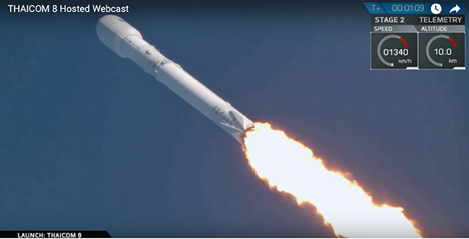
That's not surprising, as their landings were considered the most difficult yet to complete. Both missions launched communications satellites on their way to orbits more than 22,000 miles over the equator, requiring more speed.
After completing their engine burns and separating, the roughly 14-story boosters dropped more than 70 miles, entering the atmosphere at about 4,000 mph.
Descending at that high a velocity, the rockets were seared with heating five times more intense than on missions to lower orbits, such as SpaceX’s launches of cargo to the International Space Station.
Plus, the rockets had less fuel to spare for engine firings to slow their fall.
Despite those challenges, the Falcon 9 booster again deployed its legs and touched down on the football field-sized deck of the ship named "Of Course I Still Love You," prompting another celebration from the jubilant employees gathered at the SpaceX headquarters in Hawthorne, California.
When returned to shore, the Falcon 9 booster will join three other boosters stored in a hangar at Kennedy Space Center, starting to strain the hangar's capacity: the hangar can only hold five boosters.
spacex.com
thaicom.com
Some of the information contained in this story is by James Dean of Floridatoday.com.
Glonass-M Satellite Acquires Designated Orbit After Soyuz-2.1b Launch
A Russian Fregat booster has successfully delivered a Glonass-M satellite into the designated orbit, the Defense Ministry press office told TASS on May 29th.
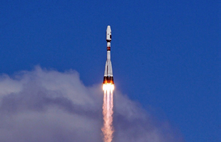
"A Soyuz-2.1b medium-class heavy carrier rocket has successfully delivered the Glonass-M Russian navigation spacecraft into the designated orbit. The carrier rocket’s launch and the injection of the spacecraft into orbit were carried out in a normal mode," the Defense Ministry said.
The carrier rocket was launched at 11:45 a.m. Moscow time (08:45 GMT) from site No. 43 of the Plesetsk cosmodrome in the Arkhangelsk Region in north Russia by an operational crew of the Russian Aerospace Force’s space troops, the press office said.
"The launch was supervised by Commander of Aerospace Force Space Troops Lieutenant-General Alexander Golovko who had arrived at the cosmodrome to control the preparation and the launch of the satellite for the Glonass orbital navigation system," the Defense Ministry’s press office reported.
All the pre-launch operations and the launch were carried out in a normal mode. Ground-based automated systems exercised control of the carrier rocket’s launch and flight, the Defense Ministry said. Ten minutes after the launch, the carrier rocket’s upper stage comprising the Fregat booster and the Glonass-M navigation satellite separated from the rocket in a normal mode. The satellite’s further injection into orbit was carried out by the Fregat acceleration unit.
This is the second launch of a Glonass-M satellite and the third launch of a Soyuz-2 medium-class carrier rocket from the Plesetsk cosmodrome this year. The flight tests of the Soyuz-2 spacecraft began at the spaceport on November 8, 2004. Over the last 12 years, 27 launches of Soyuz-2 carrier rockets in their upgraded 1a, 1b and 1v modifications have been carried out at the Plesetsk spaceport.
Glonass is Russia's satellite navigation system designed to provide Russia with its own navigation data for military and civilian use, as well as to compete with the US Global Positioning System (GPS) in the commercial market for navigation data.
New Drone Detection System
DSM Dyneema has announced that ROBIN Radar Systems has selected industry-leading Dyneema® Crystal Technology for the radome of its new Elvira® drone detection system.
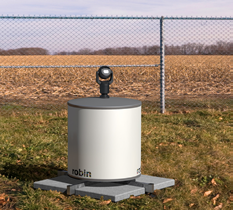
With near-zero signal loss, Dyneema® Crystal Technology helps Elvira® detect drones and classify them, distinguishing them from birds or other flying objects, at longer distances than traditional radar systems. In fact, this breakthrough radar technology can detect larger fixed-wing drones at a range of nine kilometers and smaller multi-rotor drones at up to three kilometers.
In addition to the material’s electromagnetic transparency, ROBIN Radar chose Dyneema® Crystal Technology for its superior protection of sensitive equipment in harsh outdoor environments and its extreme light weight for easy transport.
The Elvira® radomes are produced by Airborne, a partner of DSM Dyneema. The two companies collaborate to deliver next-generation radomes made with Dyneema® Crystal Technology to customers worldwide.
“Because Elvira® is looking for very small targets and must distinguish fine details to prevent false positives, we needed a radome material that could provide high transparency to minimize signal loss,” said Gerben Pakkert, head of R&D at ROBIN Radar Systems. “These rigorous requirements quickly ruled out existing alternatives. Dyneema® Crystal Technology delivers lower signal loss than any other radome material available today, allowing us to realize the full potential of our advanced radar system.”
Elvira® was specifically designed for drone detection. After winning a tender from the Dutch Ministry of Justice, ROBIN Radar applied its expertise in tracking small targets to design the new system, which launched in April 2016. Elvira® provides military-grade radar capabilities, including advanced Doppler processing that enables it to track even the most agile drones. The system is offered at a competitive price that supports broad usage in professional security scenarios, such as protecting high-profile events, airports, harbors, prisons and other critical infrastructures against drones. By combining detection and classification in just one sensor, the technology saves precious time in the decision process.
“With nearly 200,000 new drones taking to the air each month, as reported by CNBC, accurately detecting and classifying them is becoming extremely critical,” said Danielle Petra, new business development manager at DSM Dyneema. “Elvira® is an excellent example of how Dyneema® Crystal Technology is helping customers create radically new detection technologies and underscores DSM Dyneema’s commitment to supporting our customers with the most advanced security materials on the market today.”
Dyneema® Crystal Technology provides an extremely low loss tangent and approximately half the dielectric constant compared to aramid, e-glass and quartz. The electrical properties of the material maintain superior performance - even at higher frequencies from X band to millimeter band - allowing military, civil and telecommunications organizations to realize the full potential of their advanced antenna, radar, radio astronomy or communications systems.
Further, because Dyneema® Crystal Technology offers an exceptional strength-to-weight ratio and high impact resistance, it can be used in thinner gauges that enhance transmission quality even more. Its light weight also makes radomes more energy-efficient to ship and easier to maneuver and install.
Dyneema® Crystal Technology is inherently hydrophobic without the need for time-consuming and demanding secondary resin application, a property that virtually eliminates the need for regular maintenance.
dyneema.com
Satellite AIS For French Navy
exactEarth Ltd. has been selected by Telespazio France to supply Satellite AIS services to the French Navy as part of the recently announced four-year Trimaran 2 project won by a consortium of Airbus Defense and Space and Telespazio France.

Under terms of the contract, exactEarth will provide a Satellite AIS data feed of the French economic exclusion zone, which encompasses 11 million square kilometers, to Telespazio France who will provide a viewing capability to several users in the French Navy.
"This is an important strategic win which will allow us to develop business with new long-term customers," said Peter Mabson exactEarth CEO.
"Telespazio is a key name in European satellite services and the French Navy has significant global maritime surveillance and security interests. Given exactEarth's industry leading satellite AIS capabilities, our ability to now offer advanced analytics and with our real-time second generation satellite system coming on line next year, we see the opportunity to substantially grow the value of this business over the next four years starting from this beachhead contract."
DARPA Plans On More Sophisticated, Resilient + Collaborative Unmanned Air Systems
DARPA’s Collaborative Operations in Denied Environment (CODE) program seeks to help the US military’s unmanned aircraft systems (UASs) conduct dynamic, long-distance engagements of highly mobile ground and maritime targets in denied or contested electromagnetic airspace, all while reducing required communication bandwidth and cognitive burden on human supervisors.
In an important step toward that goal, DARPA recently awarded Phase 2 system integration contracts for CODE to Lockheed Martin Corporation (Orlando, Florida.) and the Raytheon Company (Tucson, Arizona). Further, the following six companies—all of which had Phase 1 contracts with DARPA to develop supporting technologies for CODE—will collaborate in various ways with the two prime contractors:
• Daniel H. Wagner Associates (Hampton, Virginia)
• Scientific Systems Company, Inc. (Woburn, Massachusetts)
• Smart Information Flow Technologies, LLC (Minneapolis, Minnesota)
• Soar Technology, Inc. (Ann Arbor, Michigan)
• SRI International (Menlo Park, California)
• Vencore Labs dba Applied Communication Sciences (Basking Ridge, New Jersey)
CODE’s main objective is to develop and demonstrate the value of collaborative autonomy, in which UASs could perform sophisticated tasks both individually and in teams under the supervision of a single human mission commander.
CODE-equipped UASs would perform their mission by sharing data, negotiating assignments, and synchronizing actions and communications among team members and with the commander.
CODE’s modular open software architecture on board the UASs would enable multiple CODE-equipped unmanned aircraft to navigate to their destinations and find, track, identify, and engage targets under established rules of engagement.
The UASs could also recruit other CODE-equipped UASs from nearby friendly forces to augment their own capabilities and adapt to dynamic situations such as attrition of friendly forces or the emergence of unanticipated threats.
“During Phase 1, we successfully demonstrated, in simulation, the potential value of collaborative autonomy among UASs at the tactical edge, and worked with our performers to draft transition plans for possible future operational systems,” said Jean-Charles Ledé, DARPA program manager. “Between the two teams, we have selected about 20 autonomous behaviors that would greatly increase the mission capabilities of our legacy UASs and enable them to perform complex missions in denied or contested environments in which communications, navigation, and other critical elements of the targeting chain are compromised. We have also made excellent progress in the human-system interface and open-architecture framework.”
CODE’s prototype human-system interface (HSI) is designed to allow a single person to visualize, supervise, and command a team of unmanned systems in an intuitive manner. Mission commanders can know their team’s status and tactical situation, see pre-planned and alternative courses of action, and alter the UASs’ activities in real time.
For example, the mission commander could pick certain individual UASs from a team, circle them on the command station display, say “This is Group 1,” circle another part of the map, and say “Group 1 search this area.” The software then creates a sub-team with the circled UASs, divides up the search task among those assets, and redistributes the original tasks assigned to Group 1 assets to the remaining UASs.
This capability significantly simplifies the command and control of large groups of UASs. Other parts of the HSI research focused on how to display the new plan, including potential impact on other mission objectives, and—depending on pre-set mission rules—either directly executes the plan or waits for the commander’s approval to act.
The HSI and autonomy algorithms are being developed in open architectures based on emerging standards: the Future Airborne Capability Environment (FACE) and Unmanned Control Segment (UCS) standards used by the US Army and US Navy, and the Open Mission Systems (OMS) and Common Mission Command and Control (CMCC) standards that the US Air Force uses.
During Phase 2, DARPA plans to implement an initial subset of the behaviors within each of the two open architectures and use those architectures to conduct live flight tests with one or two live UASs augmented with several virtual aircraft.
If those tests are successful, DARPA could move to Phase 3, in which one team would test the capabilities using up to six live vehicles cooperating among themselves and with additional simulated vehicles. A single person would command the UAS team to perform a complex mission involving target search, identification, and engagement against an active, unpredictable adversary.
CODE seeks to deliver a software system that would be resilient to bandwidth limitations and communications disruptions, yet compatible with existing standards and capable of affordable retrofit into existing platforms.
If successfully demonstrated, these scalable, cost-effective capabilities would greatly enhance the survivability, flexibility, and effectiveness of existing air platforms, as well as reduce the development times and costs of future systems.
darpa.mil/
darpa.mil/program/collaborative-operations-in-denied-environment



